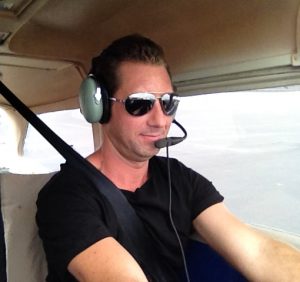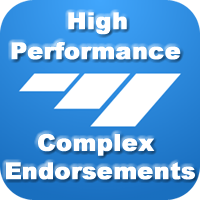High Performance & Complex
Once you have already received your PPL, you can continue to advance your skills with Alpha Aviation Flight School by earning your High Performance & Complex Endorsements.
Importance to Members
Questions regarding endorsements needed by pilots to fly complex and high-performance aircraft. With the changes to 14 CFR 61.31 in mid-1997, the FAA changed the requirements for a person to act as PIC of these aircraft. The wrong endorsement could mean a violation or invalidate your aircraft insurance.
Overview
Prior to August 1997, the FAA required a high-performance endorsement in order to act as pilot in command of an aircraft with more than 200 horsepower or that had retractable gear, flaps, and a controllable propeller. Many aircraft met this definition and were used to gain the training and endorsement, including the Cessna Cutlass 172RG, Cessna 182, and Piper Seminole, to name a few.
With the changes to Part 61 in August 1997, the FAA changed the definition of high performance and added a separate endorsement for complex aircraft. The definition of high performance is now “an airplane with an engine of more than 200 horsepower.” This ruled out numerous aircraft, including many Mooneys (200 hp), Piper Seminoles (180 hp each engine) and most of the Piper Senecas (200 hp per engine). This seemingly simple change had a significant effect on the training industry. Many flight schools needed to add new aircraft to provide this training.
![]()
![]()
The Federal Aviation Regulations (FAR’s) specify that you must receive 10 hours of flight training in an airplane with retractable landing gear, flaps, and a controllable pitch propeller. To operate as pilot in command of an airplane that meets these criteria, you will need training and an endorsement from your instructor. You also need training and an endorsement from your instructor when operating as pilot in commend in a high performance aircraft. A high performance aircraft is defined as an aircraft having an engine of more than 200 horsepower.
Technical Information

You may also notice that the definition of high performance no longer includes “retractable gear, flaps and controllable pitch propeller.” This is now considered a complex aircraft. Aircraft such as the Cessna Cutlass 172RG, many Mooneys, and the Piper Seminole, which previously required the high-performance endorsement, now require the complex endorsement. Many aircraft may require both endorsements if they have an engine of more than 200 hp and have retractable gear, flaps, and a controllable propeller.
Additional confusion arises when a pilot received training and endorsements prior to August 1997 under the old regulations. Many pilots received high-performance endorsements in aircraft with engines less then 200 hp or in aircraft without retractable gear, flaps, and controllable propellers. The question arises what training and endorsements are now required.
14 CFR 61.31 states that the training and endorsements for a complex aircraft are not required if the person has logged flight time as PIC of a complex airplane prior to August 4, 1997. The same is also true for the high-performance endorsement if the person has logged flight time as PIC of a high-performance airplane prior to August 4, 1997.
The problem with this is that the high-performance and complex aircraft that were considered high performance prior to August 4, 1997, must have met today’s definition of high performance or complex in order to qualify under this grandfather clause.
For example, if you received a high-performance endorsement in a Cessna 172 RG (not more than 200 hp) prior to August 4, 1997, and did not log any PIC time in an airplane with an engine of more than 200 hp prior to that date, then another high-performance endorsement would be required if you’re planning on acting as PIC in a Bonanza (more than 200 hp) after August 4, 1997.
This might seem confusing, but legally, and in the eyes of the FAA, your high-performance endorsement for the 172 RG does not suffice for a Bonanza, or any airplane with an engine of more than 200 hp. The only good news is that you are grandfathered from having to receive a complex endorsement if you logged PIC time in the 172 RG prior to August 4, 1997. Reason being, the 172 RG meets today’s definition of complex.
Pilots need to verify in their logbooks which types of aircraft they have logged pilot-in-command time in prior to August 4, 1997, and then determine which endorsements are needed, if any. Remember, the definition of high performance now means an engine of more than 200 hp, not an aircraft with more than 200 hp.
With the exception of our discussion on acting as PIC in high-performance and complex aircraft prior to August 4, 1997, the list below provides several examples of aircraft and the endorsements they require.
| AIRCRAFT | HIGH PERFORMANCE ENDORSEMENT | COMPLEX ENDORSEMENT |
|---|---|---|
| Cessna 172 | No | No |
| Cessna 172 Hawk XP | No | No |
| Cessna Cutlass 172RG | No | Yes |
| Cessna 182 | Yes | No |
| Cessna 182RG | Yes | Yes |
| Piper Arrow (180 or 200 hp) | No | Yes |
| Piper Seminole | No | Yes |
| Beech Bonanza | Yes | Yes |
| Mooney M20 (200 hp) | No | Yes |
| Mooney M20K (210 hp) | Yes | Yes |
![]()
Ready to take the next step to start your flight training, or just have some questions? Contact us Today! and we will be more than happy to help!

